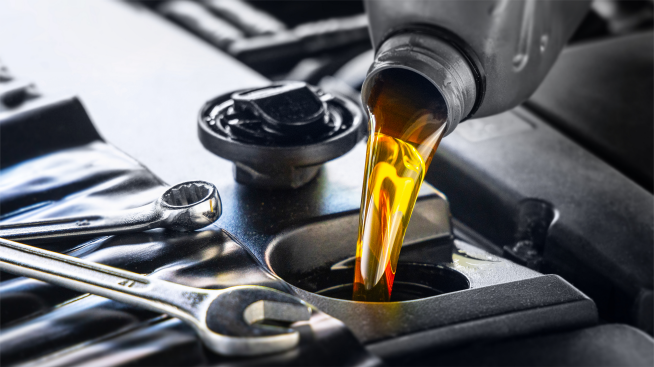What is a catalytic converter?

Your car has a lot of different parts, some of which you likely know about — such as the engine — and others that might be a little bit more of a mystery. Among those unsung heroes that quietly do their job every day is the humble catalytic converter. The catalytic converter is a key component of your exhaust system that helps to keep our air cleaner and greener.
What does a catalytic converter do?
When you start your car, the combustion reaction releases many byproducts harmful to the environment and human health. This is where a catalytic converter, typically located somewhere between the engine and the muffler, steps in. It works to reduce these dangerous pollutants in your exhaust fumes by converting them into comparatively safer gases like oxygen, nitrogen, carbon dioxide or water vapor before they’re released into the atmosphere.
Some of these gases, like carbon dioxide, are technically still greenhouse gases that also count as a form of pollution. However, the alternative without a catalytic converter would be to release carbon monoxide into the air, which is generally regarded as being more dangerous than CO2.
What is a catalytic converter made of?
A catalytic converter works to convert harmful pollutants by utilizing the power of chemistry. The inside of a catalytic converter typically houses a ceramic element coated in trace amounts of various precious metals such as palladium, platinum and rhodium. As the exhaust fumes pass over the element, these precious metals act as “catalysts” for a chemical reaction that converts the nasty pollutants into some of the safer gases mentioned earlier.
Catalytic converter theft
Unfortunately, the precious metals within catalytic converters have seen spikes in prices over the last several years. This, coupled with the fact that the part can often be removed with just a few hand tools, has led to catalytic converter theft becoming an increasingly common phenomenon across the country. The part can potentially fetch up to a few hundred dollars, often sold off to smelt shops where the precious metals are extracted.
Catalytic converter theft prevention
Some potential strategies to consider when trying to prevent catalytic converter theft from happening to your vehicle include:
- Parking in well-lit areas or secure garages: If parking in a driveway, consider installing motion sensor lights, a camera system or both.
- Consider additional alarm systems: Increasing the sensitivity levels of your current car alarm (if possible) or investing in additional alarm systems may help ward off potential theft.
- Adding additional layers of security: Purchasing aftermarket security devices like a cage or steel plates may make removing a catalytic converter more difficult. To ensure proper installation, consider having a trusted mechanic install them for you.
- Having the part marked: Asking your mechanic to engrave the catalytic converter with your vehicle identification number (VIN) could help law enforcement and reputable scrap dealers identify stolen parts. There’s also a high-temperature spray paint you could ask your mechanic to mark your catalytic converter with, which should alert scrap dealers to it being a stolen part.
- File a case report: Even if you don’t end up getting restitution, it helps to report your case to law enforcement and your insurance company. By adding to the statistics, you can put more pressure on lawmakers to act on the issue.
Signs of a stolen catalytic converter
Unfortunately, sometimes even the best preventive measures may not be enough to deter a determined thief. Some ways to tell you’ve been the victim of a catalytic converter theft include:
- Loud engine roaring, particularly when you first start the car.
- Darker, smellier exhaust fumes.
- Possible signs of damage underneath your vehicle.
Can you drive without a catalytic converter?
It’s generally illegal in most places to release those kinds of uncatalyzed exhaust fumes into the atmosphere so you’ll want to drive your car to your nearest auto shop as soon as possible for a replacement. There’s also a possibility that the thieves may have damaged the exhaust line during their heist. If it's bad enough, some of those dangerous gases might start to spill into the cabin where they pose a direct health hazard to you and your passengers.
Catalytic converter cost
If you’ve been the victim of catalytic converter theft, you’ll have to get it replaced and, sadly, they aren’t typically cheap. A replacement catalytic converter could potentially set you back up to a few thousand dollars for the part alone.
There’s an additional related cost to install it, but that has a small silver lining. The ease of access that made the part easy to steal also allows for a quick installation process.
Does insurance cover catalytic converters?
Given the high cost, you may be wondering if your insurance will cover the replacement for a stolen catalytic converter. This is largely dependent on your policy — acts of theft are typically only covered by comprehensive coverage policies as opposed to standard coverage. Even with comprehensive coverage, there may be exceptions depending on the scenario. It’s best to consult your policy documents or speak to an insurance expert to see what applies to your situation.
In summary
You may not have thought much about your catalytic converter before, but now you see what a vital role it plays in helping to keep our air clean. Next time you start your engine, take a second to appreciate the work your catalytic converter is putting in. Inside it, precious metals are turning nasty pollutants into something safer. In this way, your car has been helping to keep the air a little cleaner, one drive at a time.



